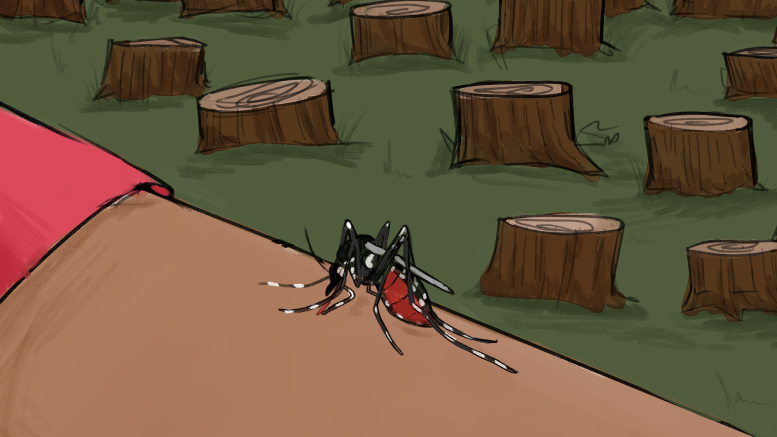Recently, there have been outbreaks of chikungunya fever across the world, affecting regions such as China, Bolivia and various countries bordering the Indian Ocean.
Symptoms of the disease include a sudden fever and debilitating joint pain. Although many patients make a full recovery, infants and the elderly are at risk of organ damage and even death. Currently, there is no specific treatment for the disease, and vaccines are not widely available nor used.
The chikungunya virus is mostly transmitted between humans by Aedes aegypti and Aedes albopictus, which are mosquitoes with a distinctive, spotted black and white colouring. When a mosquito feeds on an infected person, it too becomes infected with the virus and imparts it on whoever it feeds from next.
Chikungunya is an example of a vector-borne disease, meaning that it is transmitted to humans via living organisms, usually arthropods such as mosquitoes, ticks and flies. In this case, the mosquito passes on the disease by harboring pathogens inside its body and biting its victim.
In the transmission cycles of other diseases, however, vectors may pick up germs on the outside of their bodies and infect others through physical contact. This is how the housefly infects humans with yaws, cholera and salmonella, for example.
Chikungunya is historically endemic to tropical climates but, as of August, there have been 111 locally acquired cases in France and seven in Italy this year.
Unfortunately, the emergence of vector-borne diseases and their spread from endemic to previously low-risk locales are not purely natural phenomena — they are also results of the ever-shifting ecologies that humans create.
To fully understand the current distribution of diseases, we must first turn to the past.
Some pathogens responsible for vector-borne diseases have been around from time immemorial. The oldest sample of the malaria parasite, for instance, dates to tens of millions of years ago and was found inside a mosquito trapped inside amber in the Dominican Republic.
Hunter-gatherers in the past experienced diseases such as malaria, but around 12,000 years ago some of them started to cultivate crops, domesticate animals and settle in villages. This shift, known as the Neolithic Revolution, birthed a new set of disease dynamics, and population growth, urbanisation and animal domestication all facilitated the spread of diseases or gave rise to new ones.
Over centuries, agriculture has only grown, now with substantial changes to the environment. For example, the clearing of forests for farmlands and livestock has created more open spaces, which are favourable breeding conditions for malaria-spreading mosquitoes.
Moreover, human settlements have been encroaching into forests due to population growth and urban expansion, especially in developing countries. People who live in these newly settled areas are at a heightened risk of infection as they are more likely to encounter vectors.
Currently, the mosquito is by far the deadliest animal on Earth, claiming more than 700,000 lives each year. However, vector-borne diseases are not equally distributed across the global population. 94 per cent of malaria infections occur in Sub-Saharan Africa, while South and Southeast Asia and tropical Latin America are most affected by dengue. These are some of the least developed regions of the world where disease burden is compounded by poverty, inadequate housing and the lack of access to quality healthcare.
It may seem as though much of the Western world is spared from vector-borne diseases, but climate change has led to the expansion of disease vectors into new territories. Recently, a combination of warmer weather and floods has allowed mosquitoes and ticks to establish themselves in Europe, causing an upswing in dengue, West Nile virus and tick-borne encephalitis infections in its temperate regions. It is also suggested that Europe’s relative lack of immunity and recent experience with such diseases will cause heightened morbidity and mortality.
In Canada, Lyme disease is the most reported vector-borne disease, with most cases appearing in Ontario, Quebec and Nova Scotia. Annual infections have increased dramatically over the past two decades from 144 cases in 2009 to 5,239 in 2024, though underreporting could obscure the actual number of cases.
Canada is no exception to the global trend of increasingly numerous vectors and associated diseases. With warmer weather, ticks have longer growing seasons, more suitable habitats and more opportunities to infect people.
The rise of vector-borne diseases across the globe has provoked numerous infection control measures from habitat control to insecticide-treated bed nets, but intervention strategies are not unsullied by controversy.
In the past decade, people in malaria-stricken countries across the world have been spotted using treated mosquito bed nets as fishing nets, leading to overfishing and, potentially, the contamination of water bodies.
Despite being made illegal by governments, impoverished fishermen continue to fish with treated nets in order to make ends meet. A New York Times YouTube video has even described their situation as “fight malaria or starve.”
It has also come to light that the use of pyrethroid insecticides, a popular choice in control programs, has created selective pressure for insecticide-resistant mosquitoes, rendering control efforts less effective. Furthermore, pesticides in general may cause a loss in biodiversity by affecting the growth, reproduction and behaviour of non-target species.
The story of plagues and pests is not a simple tale of man versus insect, but a convoluted narrative involving our evolutionary past, climate change and global inequalities. There seems to be no clear solution on the horizon, but there is a growing awareness that human health is intrinsically tied to the wellbeing of our environment — perhaps this knowledge will be our most powerful tool moving forward.

